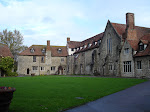.jpg)
Chaucer's first major work, The Book of the Duchess, was an elegy for Blanche of Lancaster (who died in 1369). It is possible that this work was commissioned by her husband John of Gaunt, It would appear to have been written between the years 1369 and 1374. Two other early works by Chaucer were Anelida and Arcite and The House of Fame. Chaucer wrote many of his major works in a prolific period when he held the job of customs comptroller for London (1374 to 1386). His Parlement of Foules, The Legend of Good Women and Troilus and Criseyde all date from this time. Also it is believed that he started work on The Canterbury Tales in the early 1380s. These tales would help to shape English literature.
The Canterbury Tales contrasts with other literature of the period in the naturalism of its narrative, the variety of stories the pilgrims tell and the varied characters who are engaged in the pilgrimage. The many jobs that Chaucer held in medieval society—page, soldier, messenger, valet, bureaucrat, foreman and administrator—probably exposed him to many of the types of people he depicted in the Tales. He was able to shape their speech and satirize their manners in what was to become popular literature among people of the same types.
Chaucer's works are sometimes grouped into, first a French period, then an Italian period and finally an English period, with Chaucer being influenced by those countries' literatures in turn. Certainly Troilus and Criseyde is a middle period work with its reliance on the forms of Italian poetry, little known in England at the time, but to which Chaucer was probably exposed during his frequent trips abroad on court business. In addition, its use of a classical subject and its elaborate, courtly language sets it apart as one of his most complete and well-formed works. In Troilus and Criseyde Chaucer draws heavily on his source, Boccaccio, and on the late Latin philosopher Boethius.
Chaucer also translated such important works as Boethius' Consolation of Philosophy and The Romance of the Rose by Guillaume de Lorris.
Chaucer wrote in continental accentual-syllabic metre, a style which had developed since around the twelfth century as an alternative to the alliterative Anglo-Saxon metre. Chaucer is known for metrical innovation, inventing the rhyme royal, and he was one of the first English poets to use the five-stress line, a decasyllabic cousin to the iambic pentameter, in his work, with only a few anonymous short works using it before him. The arrangement of these five-stress lines into rhyming couplets, first seen in his Legend of Good Women, was used in much of his later work and became one of the standard poetic forms in English. His early influence as a satirist is also important, with the common humorous device, the funny accent of a regional dialect, apparently making its first appearance in The Reeve's Tale.
Chaucer's English
Chaucer is sometimes considered the source of the English vernacular tradition and the "father" of modern English literature. His achievement for the language can be seen as part of a general historical trend towards the creation of a vernacular literature after the example of Dante in many parts of Europe.
The poet Thomas Hoccleve, who may have met Chaucer and considered him his role model, hailed Chaucer as "the firste fyndere of our fair langage." John Lydgate referred to Chaucer as the 'lodesterre...off our language'. Around two centuries later, Sir Philip Sidney greatly praised Troilus and Criseyde.
Modern English is somewhat distanced from the language of Chaucer's poems owing to the effect of the Great Vowel Shift some time after his death. This change in the pronunciation of English, still not fully understood, makes the reading of Chaucer difficult for the modern audience, though it is thought by some[who?] that the modern Scottish accent is closely related to the sound of Middle English. The status of the final -e in Chaucer's verse is uncertain: it seems likely that during the period of Chaucer's writing the final -e was dropping out of colloquial English and that its use was somewhat irregular. Chaucer's versification suggests that the final -e is sometimes to be vocalised, and sometimes to be silent; however, this remains a point on which there is disagreement. When it is vocalised, most scholars pronounce it as a schwa. Apart from the irregular spelling, much of the vocabulary is recognisable to the modern reader. Chaucer is also recorded in the Oxford English Dictionary as the first author to use many common English words in his writings. These words were probably frequently used in the language at the time but Chaucer, with his ear for common speech, is the earliest manuscript source. Acceptable, alkali, altercation, amble, angrily, annex, annoyance, approaching, arbitration, armless, army, arrogant, arsenic, arc, artillery and aspect are just some of those from the first letter of the alphabet.
Seventeenth and eighteenth century writers, such as John Dryden, admired Chaucer for his stories, but not for his rhythm and rhyme, as few critics could then read Middle English and the text had been butchered by printers, leaving a somewhat unadmirable mess. It was not until the late 19th century that the official Chaucerian canon, accepted today, was decided upon, largely as a result of Walter William Skeat's work.
One hundred and fifty years after his death, The Canterbury Tales was selected by William Caxton to be one of the first books to be printed in England.


No comments:
Post a Comment